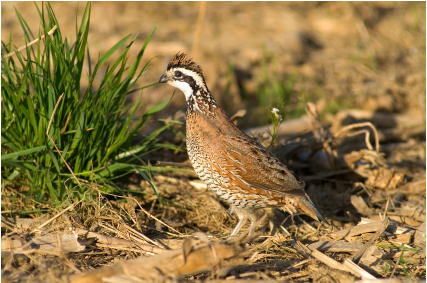
The best-known species in the United States is the northern bobwhite, named from the loud call of the male. A popular game bird, it was originally resident east of the Rockies and north to southern Ontario and New England; it has been successfully introduced in parts of western North America, the West Indies, and New Zealand. It is 21 to 26 cm (8.5 to 10.5 in) long, with a slight crest. Males of the northern populations are reddish brown above and white, barred with black, on the belly. The throat and a line above the eye are white; a broad black line extends from the eye backward and around the throat. This white area is replaced by buff in the otherwise similar females. In subspecies from the southwestern United States and parts of Mexico, the face, throat, and variable amounts of the rest of the underparts are black.
Monogamous, after the breeding season, bobwhites gather into coveys—groups that may number over 100 birds—dispersing during the day for feeding and reassembling at night or in adverse weather. The members of the covey seek warmth and protection by huddling in a circle, with their heads turned outward. If frightened, bobwhites (like most quail) prefer to run from danger; when flushed, they fly rapidly with a loud whirring sound, but quickly drop to earth. (The information above is from Msn Encarta)
Bobwhite Quail are generally seen in the wild in the Midwest and Southern United States as well as parts of Mexico. Bobwhite quail are small, chunky birds and usually travel on foot and stay in a limited area. Bobwhite quail are primarily seed eaters, although they do eat some insects in the wild.
Bobwhite Quail chicks are tiny- about the size of bumblebees. Bobwhite Quail, noted for its flavorful meat, has become a high-end alternative to chicken for many connoisseurs. The bobwhites probably have the largest number of calls with at least 19 distinct calls. Jumbo Wisconsin and Georgia Giant are also a variety of the bobwhite quail. Breeding of Northern Bobwhites is now a profitable business.
Bobwhite quail, especially the young chicks, are sensitive to poor feed quality. Most successful producers typically raise breeders with the intent to market the resultant chicks at one day of age to growout producers, or they specialize in the growout of day-old chicks until approximately 17 weeks of age to sell as flight-ready birds to game preserve owners.
Coccidiosis normally attacks birds at the age of 2-6 weeks and birds that are on litter or ground environment. Using a proper starter feed can help with prevention of this disease. Wet litter and buildup of droppings around waterers and feeders is a common source of overwhelming infections. Nipple waterers significantly reduce the occurrence of wet litter and are simpler to clean than trough waterers.
The two basic production facilities used for producing Bobwhite quail are referred to as flight pens and quail barns. Breeders are typically housed in one of three ways: in large community floor pens, in smaller communal cages designed for 10 to 20 birds each, or caged as pairs or trios.
My Thoughts on Raising Bob White Quail.
The Bob White Quail adapt very well to the captive environment. When it comes to raising Quail for a beginner. I would recommend raising the Bob White Quail as a possible first or second choice.
Incubation period for Bob White Quail eggs is 21 to 23 days. This Quail reaches maturity at around 16 weeks of age and should be laying eggs at 21 to 25 weeks of age. When raising the Bob White Quail in a proper environment, with the right pairing, diet and good management skills. The female is capable of laying 100 eggs or more per year.


